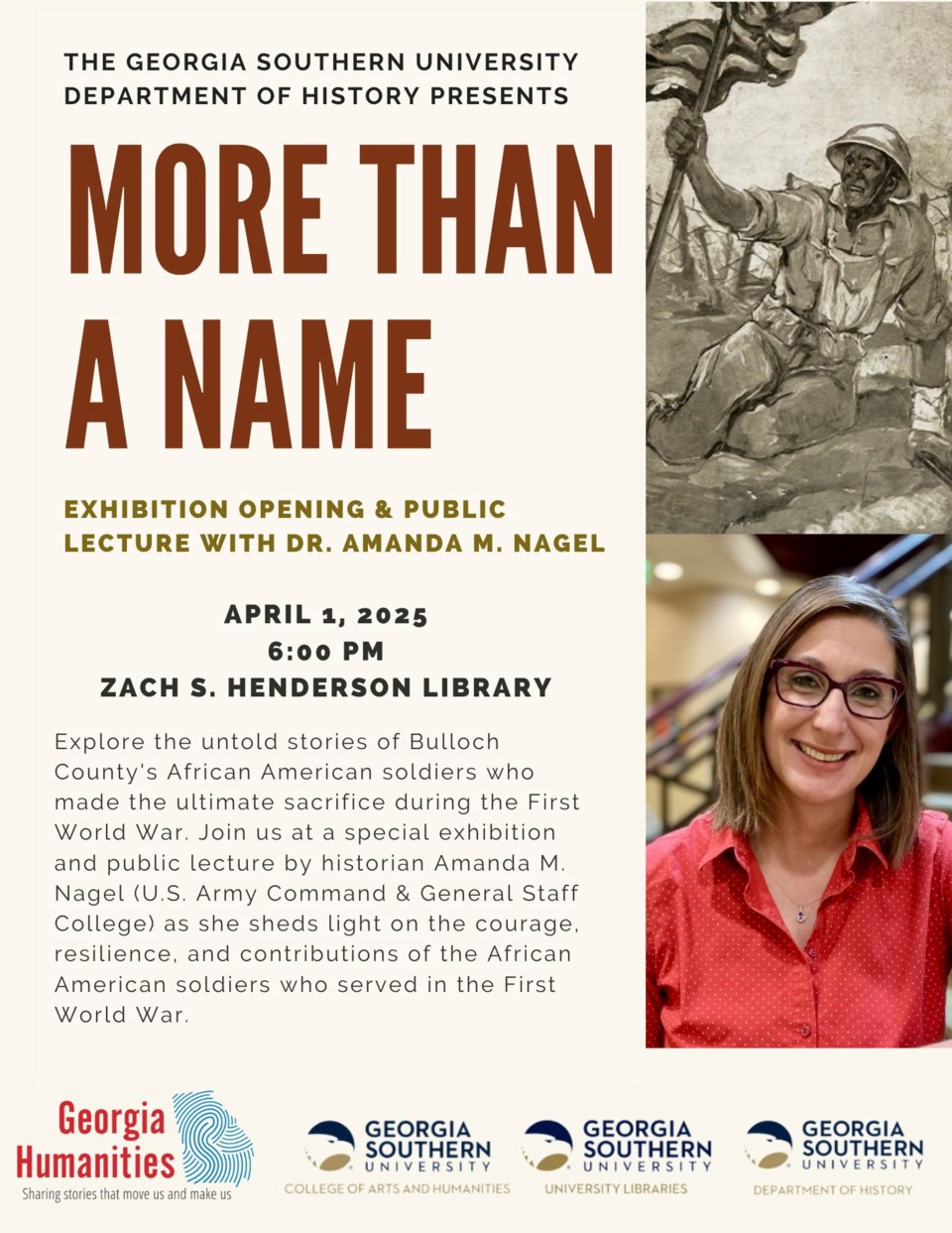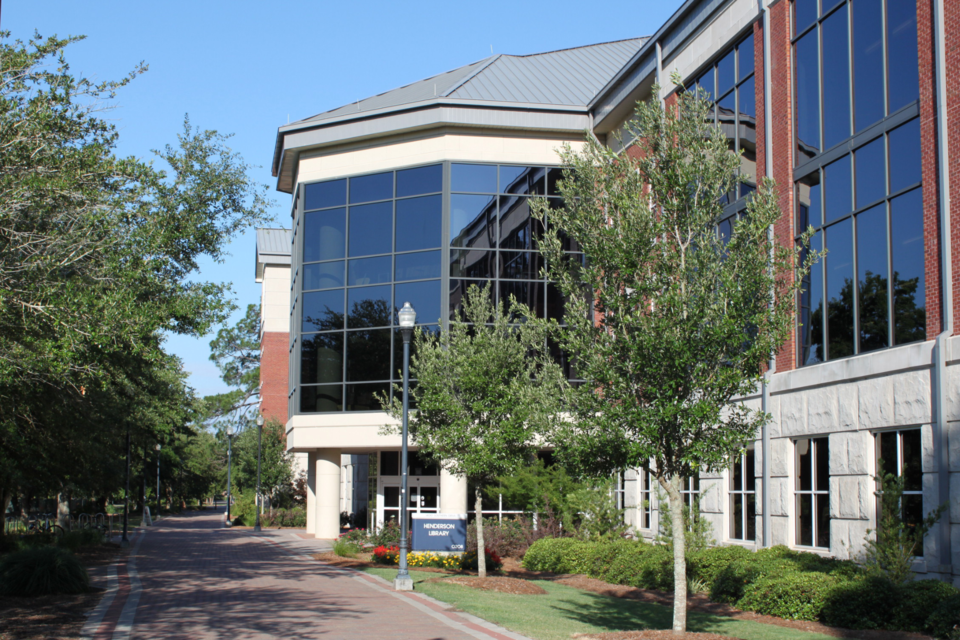Georgia Southern history professor Brian K. Feltman, Ph.D., is creating an exhibit honoring the African Americans from Bulloch County who made the ultimate sacrifice during the First World War.
“More than a Name: Commemorating Bulloch County’s African American Fallen Soldiers of the First World War” will debut at Georgia Southern’s Henderson Library in March 2025 and run until July.
Twenty-six Bulloch County natives died in the First World War. Thirteen of them were African American. The exhibit, funded by Georgia Humanities, serves as not only a look back in remembrance but also a look into the lives of these men as they fought for a country that, at the time, viewed them as second-class citizens.
The impetus for this project was twofold. A German historian who wants his students engaged in research, Feltman said primary sources or sources in German can be challenging to study. To circumvent this, he often uses local sources. This was the origin of the idea for the exhibit.
The service of African Americans became the focus shortly after Feltman and his students began their research.
“We realized that it was easy to find a lot of information about the white veterans and the white fallen soldiers, but the African Americans who served and died had really been marginalized,” he said.

Feltman elaborated that while documentation such as draft cards and ledgers were relatively easy to find for Black soldiers, there was very little in the way of public acknowledgment, either before or after the war. Perhaps the most tangible example of this is the absence of photographs of any of the 13 fallen soldiers included in the exhibit.
Feltman said this shortage wasn’t limited to photos: “The memory of the First World War is significant within the African American community. In the exhibit, we’ll display many books by African American authors about the African American experience. Still, within the broader community, this experience has been forgotten.”
The exhibit will include biographical information, photos of their gravesites, and their responsibilities specific to their regiment or battalion. Additionally, there will be original posters featuring African American soldiers and their families and era-specific covers of the NAACP’s official magazine “The Crisis.”
In addition to honoring the soldiers, the exhibit aims to place their service in its proper context. That context includes what Feltman referred to as the “everyday reality” of racism. Bulloch County remained a rural area in the early twentieth century. Despite nearly 50 years since the Civil War, the area and the entire South still felt its effects. A fact that isn’t lost on Feltman.
“At the time, many African Americans worked in agriculture,” he said. “A lot of their grandparents would’ve been enslaved, so these people were still very much coming out of the experience of the Civil War.”
While preserving and contextualizing the history, Feltman also prioritized community and student engagement—two critical facets given the localized nature of the topic and the fact that many of his students are Bulloch County natives.
The community engagement aspect can sometimes be challenging. As Feltman says, these sorts of exhibits often have a short lifespan and are only showcased temporarily. Fortunately, the Willow Hill Heritage & Renaissance Center is here to keep it alive. Following the display at the Georgia Southern Museum, the exhibit will be donated to the Willow Hill Heritage & Renaissance Center in Portal.
Willow Hill was a school for African American children founded initially by formerly enslaved families of Bulloch County. In 1920, it was sold to the Bulloch County Board of Education and became an integrated public school in 1971. It operated for 125 years and eventually reopened as a museum for African American history in 2005.
Alvin Jackson, M.D., the current board president whose grandfather served in the war, is keen to house the exhibit for years to come.
“It’s quite an honor,” he said. “The stories of these soldiers are personal to many of us, and we are so excited that we can continue to tell them.”
“Willow Hill does so much with the African American community,” Feltman echoed. They serve as a real hub in Bulloch County for teaching the current generation and helping them understand what they are a part of in terms of local history.”
Feltman said his students played a key role in making this exhibit a reality.
Each student in the Spring 2024 session of his class on World War I was given a Bulloch County veteran or a topic related to their service to research. Feltman says this hands-on experience is vital for students in the short and long term.

“The students did all their own research; this wouldn’t be possible without them,” he said. “We understand that students need to be involved and have that real-world experience, something they can show potential employers when the time comes.”
Feltman says special collections librarian Autumn Johnson and her team helped the students access important materials.
“Special Collections had some valuable resources in the form of American Legion auxiliary files,” he said. “We’re also borrowing materials from universities like Johns Hopkins and Indiana University. That’s a complicated process, and Autumn Johnson has been key in making that happen.”
Ultimately, Feltman hopes that community members of all backgrounds will take pride in the bravery and sacrifice of these men and take time to reflect on their story and its retelling. Alvin Jackson agrees.
“I come from a community of storytellers, said Jackson.”They have kept so many of these stories alive from the days of enslavement and beyond. This exhibit would be another important story that has not been fully told, and it will empower us to know more about what I call archival silence, where the stories are not in the history book. Still, we tell those stories to add another chapter to Bulloch County and American History.”
An exhibition opening event will be held April 1 at the Henderson Library. It will feature a free public lecture by Amanda Nagel of the School of Advanced Military History at Ft. Leavenworth. See additional details below.

Learn more about the exhibit and the research behind it by visiting https://georgiasouthern.libguides.com/bullochmemorial.




